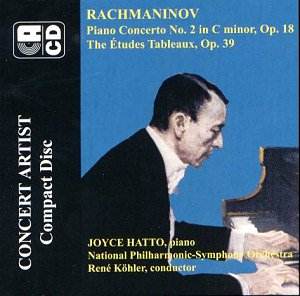This is the last of the cycle of Joyce Hatto’s
Rachmaninov Concerto recordings that I have reviewed on this site.
I have admired them all but even then none as much as this one,
which has a splendid and sensitive Concerto performance followed
by a stunning set of the nine Études-Tableaux. The Concerto
opens with quietly grave nobility tinged with an admixture of
determined strength. Soon the middle orchestral voicings are being
given prominence by Köhler, the predominately cellistic sonority
he cultivates here one of apposite depth. Hatto’s unhurried eloquence
is extended by her unselfconscious but minutely graded treble
and one hears detail often submerged in more generically romanticised
performances. She maintains clarity without becoming at all clinical
but the clarity is vital in matters of voicing, harmonic pointing
and structural and architectural integrity. With her the musical
line is unflinchingly honest and direct. Her technique in the
slow movement is excellent – her tone beautiful and the rhythmic
component tight and precisely calibrated, and there is at all
times with Hatto a sense of sure directional pull, tracery allied
to motion. Particularly appealing in the orchestral context were
the softened string entries. In the finale the architecture is
true, the imagination crisp and pleasurable, the rise and fall
of the line mirrored with excellent understanding, the sense of
tension and romantic release acute. She cultivates atmosphere,
it’s undeniable, but never at the expense of the long line. The
conclusion mirrors the introduction of the concerto – restrained
nobility, with the solo piano subsumed, as it were, into the fabric
of the orchestral patina, the work ending in a spirit of triumphant
reconciliation and wholeness.
It so happens that Evgeny Kissin has a disc that
similarly harnesses the Second Concerto to the Op. 39 Etudes –
though he doesn’t play 3, 7 and 8. I listened for points of comparison
and distinctive individuality between the young lion, Kissin,
and the pianist who first came to prominence in the 1950s. How
telling the vision and sensitivity of the older musician, how
fallible and heedlessly impetuous the young lion sounds measured
against her. In every case Hatto emerges not simply triumphant
but magisterial. Her conception, her sound world, her sense of
narrative and her powerful individuality are components of a wholeness
of understanding of these works. The opening C minor shows the
disjunctions between them – he is a touch steely and hard, clearly
taking more obviously to heart the injunction Allegro agitato.
Hatto is notably quicker, more decisive; more mature both
architecturally and tonally. One can hardly deny Kissin his superbly
weighted tone in the A minor [no. 2] – it’s truly marvellous but
equally it’s put to the service of a rather etiolated tempo and
Kissin’s directional sense never matches his tonal beauty. As
a result he emerges rather directionless, both melodically and
harmonically. Hatto’s greater speed is accompanied by what it’s
best to characterise as a vertical sense – harmonic and lyric.
Maybe she can’t match Kissin at some moments for sheer concentrated
beauty of tone but the music makes infinitely more narrative sense
in her hands. She drives powerfully through the F sharp minor
Tableau without ever losing rhythmic control and without
pressing too viscerally hard. In the B minor [No. 4] which Rachmaninov
said was to do with a Fair scene, one can admire Kissin’s golden
halo of sound – but also note that it blunts the energy and decisiveness
of the music. But both he and Hatto are good here at the joviality
and teem of the music. In the Appassionato of No. 5 in E flat
minor she is again quicker, more glinting and also more inward
with great weight of left hand tone through which she never forces.
She is not as obviously romanticised as Kissin but our narrative-pictorial
sense is far more vividly engaged by her performance. And so with
the Little Red Riding Hood allegro of No. 6; Kissin is malign
and theatrical with powerful ascents and climaxes and his dynamics
are powerful. She’s actually far, far wittier (his rather wintry
sense of humour is seldom indulged) and impish and actually more
tempestuous – also incidentally warmer and considerably more imaginative.
She has the wisdom and maturity to know how this Tableau works,
as Kissin does not. The lento seventh coalesces pictorial elements
with absolute seamlessness and drive and the Allegro moderato
[the Eighth in D minor] has rhythmic power in profusion but observes
that moderato direction acutely. The lyric curve is never compromised
in this excellent performance. She brings a wonderful and enlivening
sense of colour and controlled animation to the last Tableau –
the chordal flourishes especially. At the same basic tempo as
Kissin she manages to etch things more sharply, to conjure a greater
sense of meaning – in short to play with a greater ranger of nuance
and understanding.
The notes are very good, drawing attention to
the pictorialism inherent in the music and also letting slip an
intriguing reminiscence of Moiseiwitsch (he claimed to have know
the programme of the Op. 33 Tableaux but never let on). As for
the performances – memorable.
Jonathan Woolf
